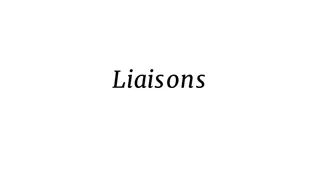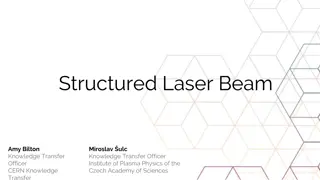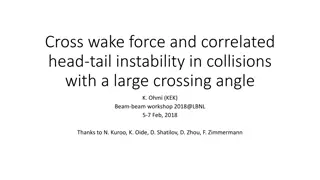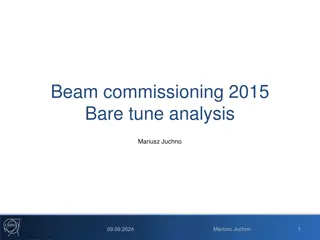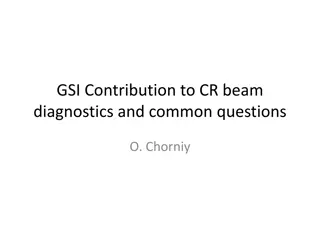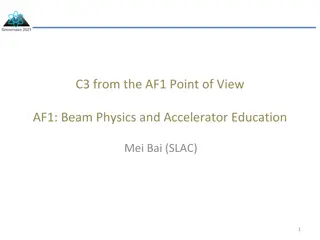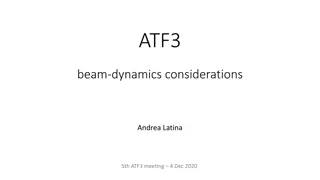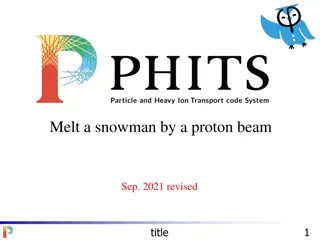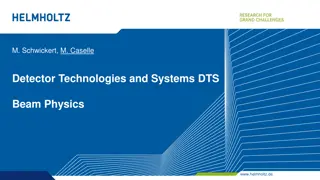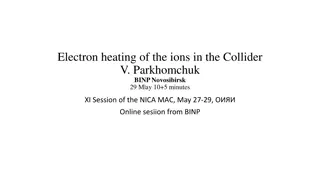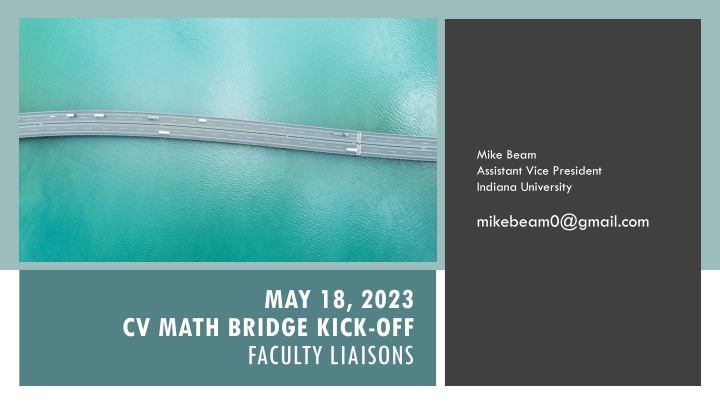
Faculty Liaisons Role in Dual Credit Programs
Understand the crucial role of Faculty Liaisons in dual credit programs, ensuring alignment with college standards and student preparation. Learn about instructor selection, training, support, and more to enhance student experiences. Explore foundational beliefs and the significance of replicating college conditions in high school settings for effective transition.
Download Presentation

Please find below an Image/Link to download the presentation.
The content on the website is provided AS IS for your information and personal use only. It may not be sold, licensed, or shared on other websites without obtaining consent from the author. If you encounter any issues during the download, it is possible that the publisher has removed the file from their server.
You are allowed to download the files provided on this website for personal or commercial use, subject to the condition that they are used lawfully. All files are the property of their respective owners.
The content on the website is provided AS IS for your information and personal use only. It may not be sold, licensed, or shared on other websites without obtaining consent from the author.
E N D
Presentation Transcript
Mike Beam Assistant Vice President Indiana University mikebeam0@gmail.com MAY 18, 2023 CV MATH BRIDGE KICK-OFF FACULTY LIAISONS
AGENDA Introduction Brief Background Liaison Role Foundational Assumptions Mike s Maxims Real talk about quality practices Questions
INTRODUCTION / WHY ME 1999 2006 2016 Concerns about quality of DC delivery Began leading a program (1,600 students) Board & Commission member (100 accreditation apps) NACEP, Accreditation, Conferences 20,000 students, 900 instructors, 25 faculty liaisons Began accreditation reviews 2000 2004 2008 2023
FOUNDATIONAL BELIEFS Objective of dual credit is to develop HS student agency, aspirations, and competence around being a college student, and college going. Dual credit programs should engage students in classroom and process experiences that reflect the academic (student) and operational (college going) habits, experiences and requirements of college students. These experiences allow students to become prepared for what comes next through role rehearsal.
FOUNDATIONAL BELIEFS This requires replicating the conditions that college students experience to the greatest degree feasible in the HS setting. The role of the Faculty Liaison is to ensure that this happens, at the course level.
FACULTY LIAISONS Replicating the academic/course experience 2+2 cycle Instructor selection (faculty must be included) Training ------------------------------------- Observations /student learning Continued support
FACULTY LIAISONS Selection (faculty must be included) Within institutional, state, and accreditor rules, identify the academic and experiential background that prepares a person to teach YOUR course This is an academic decision as much as possible lean into academic preparation https://www.boisestate.edu/concurrentenrollment/ce-instructors- and-counselors/become-an-instructor/
FACULTY LIAISONS Training Why is this necessary? Aren t they better at teaching than us? When? What should be covered? How much? What about teacher input?
Assumption #1: Your courses are different substantively than high school courses Assumption #2: Teachers do not posses an inherent understanding of the substantive differences TRAINING (WHY IS THIS NECESSARY?) Assumption #3: HS teachers can be trained to replicate your courses Assumption #4: On-campus faculty should transfer this knowledge
TRAINING (WHEN) Always before In time for teacher and school to obtain materials In time for teacher to develop instructional plans In time for HS admin to be informed of potential issues When teachers can be present
Maxim #1: the greater variation allowed, the bigger the burden on liaison to ensure sameness (increasing training burden) [academic freedom?] Maxim #2: train the teachers to teach your actual course, not a modified HS course TRAINING (WHAT SHOULD BE COVERED?) Maxim #3: make it all explicit, sharing why is as important as what and how Maxim #4: it s impossible to prepare teachers enough, so try to do too much Maxim #5: if you do only one thing well, make it training
TRAINING (WHAT SHOULD BE COVERED?) ------------------------------------------------------------------------ Assignments + schedule Other assessments ------------------------------------------------------------------------ Common problems/bottlenecks Pedagogy Disciplinary context Course philosophy Future relevance Rationale for course approaches the why Syllabus Textbook Course policies Grading scale Academic misconduct (90%) (50%) (30%) (10%)
TRAINING (MORE) Cognitive demand - complexity of course material High/low workload & work type outside of class Pace, amount of material covered v. depth Independence (agency, independence, shared learning) Frequency, depth, style and purpose of feedback Complexity of course structure (many steps, integrated assignments, etc.) Assessments objectives / styles high stakes, relationship to other assignments Level of preparation required a priori skills, knowledge, etc. Adapted from: Wyse S. A. Soneral P. (2018). Is This Class Hard? Defining and Analyzing Academic Rigor from a Learner s Perspective. CBE Life Sciences Education, 17(4), ar59. https://doi.org/10.1187/cbe.17-12-0278
SAMPLE #1: VERY COMMON, PLEASE DONT New Teacher Training Agenda 9/9/2023 from 3:00-4:30pm 1. Introductions 2. Program policies and resources 3. Canvas access and support 4. Course details 1. Syllabi, curriculum, grading, submitting grades
SAMPLE #2: UNCOMMON, PLEASE DONT Dear Teacher Gutierrez, I am please to welcome you as a Biology 1 L150 instructor. Please review the attached syllabus, sample course schedule, and approved text list. You ll see in the syllabus that we want students to be graded using a variety of methods, inclusive of labs and exams. If you d like any help or suggestions on developing labs, or if you d like me to review exams before students take them, please don t hesitate to reach out to me
BETTER APPROACHES TO TRAINING Syracuse University https://supa.syr.edu/summer-institute/ Required 1-week residential for all courses Deep focus on content, assessment, instruction, and context Indiana University https://schoolhandbook.acp.iu.edu/trainings-and-seminars/new- instructor-trainings.html Required 2-5 day residential or virtual for all courses Deep focus on content, assessment, instruction, and context South Texas College https://www.southtexascollege.edu/dual/isd- partners/files/Dual-Credit-Instructional-Manual.pdf Highly detailed role expectations for instructor training
Teacher input should inform conversations around: Context for preparedness (level of material, expectations, etc.) TRAINING (TEACHER INPUT?) Context for complexity of replication (ENL, migration, scheduling, etc.) Potential for supplemental materials Feasibility of text and material use, or need for legitimate alternatives
OBSERVATIONS / STUDENT LEARNING Goal: Determine the following College courses offered in the high school are delivering the same content, rigor, experiences, expectations, and learning opportunities as the courses offered on- campus at the sponsoring college Students enrolled in dual credit courses are held to the same standards and methods of achievement as students in on-campus courses Instructor actions align with those of on-campus faculty (i.e. feedback, grading, instructional approaches, etc.)
OBSERVATIONS / STUDENT LEARNING Strong practices Collect data on instruction and assessment Leverage data that can be collected virtually, or via artifacts Unless HS classroom / building conditions are impacting effective course delivery (no labs, etc.), focus visits and observations on core factors of the course Do note classroom or school-context that is impacting efficacy Note issues that could inform annual professional development
OBSERVATIONS / STUDENT LEARNING Resources: NACEP Issue Brief: the Classroom Visit https://www.nacep.org/docs/accreditation/IssueBrief%20- TheClassroomVisit9.6.19Final2.pdf NACEP Resource: Site Visits https://nacep.org/docs/accreditation/2019_NACEP_Miniseries_Curric ulum3_FINAL.pdf
CONTINUED SUPPORT NACEP language is annual professional development https://nacep.org/docs/briefs/F3-PDforContinuingInstructors.pdf Too many programs default to nominal approaches rather than support teachers through informed development and support approaches: Book clubs Topical Webinars Conferences
Replicating the academic/course experience 2+2 cycle CONTINUED SUPPORT Instructor selection (faculty must be included) Training ------------------------------------- Observations /student learning Continued support
CONTINUED SUPPORT (BETTER PRACTICE) Continued support should reflect course or discipline-specific issues, needs, opportunities, and iterations Continued support should be informed by instructor observations, reviews of student work, review of course outcome data, adaptations to on-campus curricula, pedagogies, etc The format of continued support is less important than what the support provides
CONTINUED SUPPORT (BETTER PRACTICE) Monthly virtual check-ins Half-day or day-long work-sessions on common struggles teachers are having Instructional workshops around student bottlenecks Annual grade norming sessions Discussions on emerging research that inform/relate to course objectives
LAST STEP Share all the above with CEP program staff & academic leadership!

